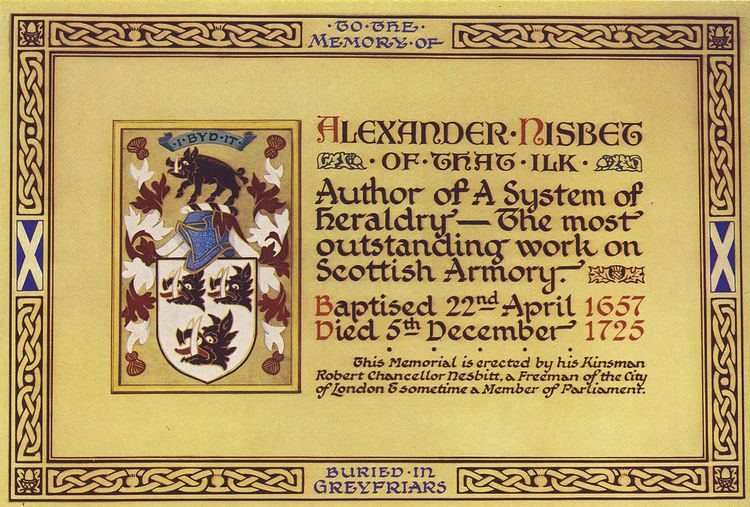Name Alexander Nisbet | Died 1725 | |
 | ||
Books A System of Heraldry, Speculative and Practical: With the True Art of Blazon According to the Most Approved Heralds in Europe | ||
Alexander Nisbet (1657-1725) was a Scottish lawyer and antiquarian. He is remembered for his works on the subject of heraldry, which are generally considered to be some of the most complete and authoritative ever produced in Scotland.
Contents
Life
Nisbet was born in Edinburgh, the third child and first son of Adam Nisbet, WS, and his wife Janet Aikenhead. Adam, and later Alexander, were chiefs of the ancient Nisbet family, of Nisbet in Berwickshire; however, the family had recently lost most of their wealth due to their zealous support of King Charles in the Civil War, and had been forced to sell their family seat, which they had owned since the 12th century. As such, Alexander lived most of his life in Edinburgh and did not have access to much of his family's old papers and records. Not a lot is known of his early life, but in his Essay on Additional Figures and Marks of Cadency he remarks that he "had a very early inclination to the study of herauldry, and when a boy I have looked on its figures with wonder, and often wish'd to know their names and signification."
Nisbet matriculated at Edinburgh University in 1675, where he studied philosophy. After graduating in 1682, he was employed as a solicitor for a number of years before giving it up in order to devote his full time to the study of heraldry. He later became a private tutor, instructing various members of the nobility and gentry on heraldry, including the Earl of Carnwrath. In a manuscript copied by Robert Mylne he is described as a "teacher of herauldrie".
Around the turn of the 18th century he set out to create a comprehensive treatise on heraldry. He initially intended to obtain funding via subscription, but finding that this would not produce enough money, he appealed to the Scottish Parliament for help. Though they initially promised him £250, this was never delivered, and the passing of the Act of Union put an end to any chance of further parliamentary assistance. Nisbet's System of Heraldry was finally published in 1722, over twenty years after he had first set out to write the work. He died three years later, on 5 December 1725, and was buried close to the Nisbet Tomb in Greyfriars Kirk; unfortunately it is likely he died in poverty. Upon his death fellow antiquarian George Crawford wrote of him: "He was a worthy, modest gentleman, who had as many friends and as few enemies as any man I have known." The exact location of his grave and any marker once present there have now been lost, but in 1934 Nisbet's kinsman, Robert Chancellor Nesbitt, arranged for John Buchan to unveil a memorial plaque in the kirk, which can still be seen today.
Nisbet became somewhat less reputable when it was noticed that in the second volume of his work he mentioned that he had sold his ancestral chieftaincy and the right to use his arms to a junior branch of the family, the Nisbets of Dean, since "the only lineal male representer (the author of this System) is like to go soon off the world, being an old man, and without issue male or female." However, this was later discovered to have been secretly added by the Nisbets of Dean themselves, and no such passage appears in Alexander's original manuscripts. This accompanied several revisions throughout the second volume, made by the editor Robert Fleming. Frequently passages which had been written succinctly by Nisbet were made needlessly verbose, and references to the Jacobite cause were removed. No edition entirely faithful to Nisbet's original manuscripts has yet been published.
Nisbet never married, and as such, the linear line of the Nisbets of that Ilk ended upon his death. The family's chieftaincy remained vacant for two hundred and seventy years, until 1995 when the claim of Robert Anthony Ellis Nesbitt was recognised by the Lord Lyon King of Arms. Robert was descended from a second son of Alexander's great-grandfather Sir Philip Nisbet of that Ilk, making Robert and Alexander second cousins seven times removed. The current chief of the family is Robert's son Mark Nesbitt of that Ilk, Alexander's second cousin eight times removed.
Nisbet died in 1725 and appropriately was buried in Greyfriars Kirkyard in Edinburgh.
